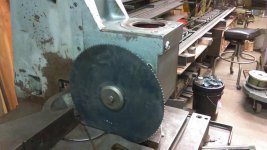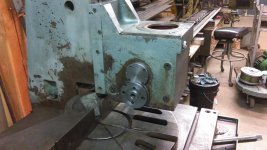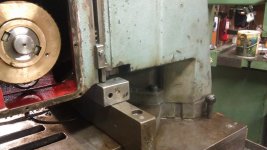M. Moore
Titanium
- Joined
- Jun 8, 2007
- Location
- Vancouver Island, B.C. Canada
Just in the process of rebuilding the badly neglected and modified machine.
Anyone out there have one of these or a manual for a similar machine?
I think the model is VMS-5. Here is a link to photos of the exact same machine.
Cold Circular Saw EISELE - semiautomatic VMS 5 - PV Saws used machines
I have some basic questions on the air/hydraulic stroke system. Does the ram cylinder have oil above and below the piston? The air line heads into the top cap but there was oil above the piston, the piston is quite different from a normal oil only setup. The rod is also bored out inside and has small inlet grooves at the top (below the piston) to allow oil inside, then a small valve at the bottom of the rod where it connects to the gearbox. The knob can be seen in the photos, it is a small valve and I am wondering about its purpose? Is it to bleed the system? I can provide pics of the piston and rod as it is all apart at the moment.
The unit uses a variable valve on the return oil side to control the down stroke, that is simple to understand. Then the oil flows into the reservoir which has a sight glass to monitor the oil level. The reservoir is also pressurized with air to provide the upstroke with the auto cycle air valves.
I have taken apart the main cylinder but have not done anything yet with the reservoir and wondered if there is just air and oil inside or are they separated somehow?
Right now I am putting new bearings into the gearbox and have some questions about what we found inside. The worm wheel was installed with all of the spring washers facing the same direction and the wheel and gear seemed to be mis-aligned. Why would the worm wheel need a spring type spacer for positioning? Why not have the correct size spacer and tighten it down, done?
I am just waiting on some metric o-rings and then I will be reassembling the gearbox and check the alignment of the worm and wheel, hopefully with the springs correctly installed it will line up on centre.
Thanks for any and all help in getting this old machine up and running again.
I will list all the damage that Bubba did in a future post.
Michael
Anyone out there have one of these or a manual for a similar machine?
I think the model is VMS-5. Here is a link to photos of the exact same machine.
Cold Circular Saw EISELE - semiautomatic VMS 5 - PV Saws used machines
I have some basic questions on the air/hydraulic stroke system. Does the ram cylinder have oil above and below the piston? The air line heads into the top cap but there was oil above the piston, the piston is quite different from a normal oil only setup. The rod is also bored out inside and has small inlet grooves at the top (below the piston) to allow oil inside, then a small valve at the bottom of the rod where it connects to the gearbox. The knob can be seen in the photos, it is a small valve and I am wondering about its purpose? Is it to bleed the system? I can provide pics of the piston and rod as it is all apart at the moment.
The unit uses a variable valve on the return oil side to control the down stroke, that is simple to understand. Then the oil flows into the reservoir which has a sight glass to monitor the oil level. The reservoir is also pressurized with air to provide the upstroke with the auto cycle air valves.
I have taken apart the main cylinder but have not done anything yet with the reservoir and wondered if there is just air and oil inside or are they separated somehow?
Right now I am putting new bearings into the gearbox and have some questions about what we found inside. The worm wheel was installed with all of the spring washers facing the same direction and the wheel and gear seemed to be mis-aligned. Why would the worm wheel need a spring type spacer for positioning? Why not have the correct size spacer and tighten it down, done?
I am just waiting on some metric o-rings and then I will be reassembling the gearbox and check the alignment of the worm and wheel, hopefully with the springs correctly installed it will line up on centre.
Thanks for any and all help in getting this old machine up and running again.
I will list all the damage that Bubba did in a future post.
Michael








